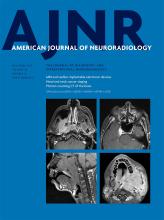Index by author
December 01, 2017; Volume 38,Issue 12
Imbriaco, M.
- Adult BrainYou have accessRedefining the Pulvinar Sign in Fabry DiseaseS. Cocozza, C. Russo, A. Pisani, G. Olivo, E. Riccio, A. Cervo, G. Pontillo, S. Feriozzi, M. Veroux, Y. Battaglia, D. Concolino, F. Pieruzzi, R. Mignani, P. Borrelli, M. Imbriaco, A. Brunetti, E. Tedeschi and G. PalmaAmerican Journal of Neuroradiology December 2017, 38 (12) 2264-2269; DOI: https://doi.org/10.3174/ajnr.A5420
Ito, K.
- EDITOR'S CHOICEExtracranial VascularOpen AccessPreoperative Cerebral Oxygen Extraction Fraction Imaging Generated from 7T MR Quantitative Susceptibility Mapping Predicts Development of Cerebral Hyperperfusion following Carotid EndarterectomyJ.-i. Nomura, I. Uwano, M. Sasaki, K. Kudo, F. Yamashita, K. Ito, S. Fujiwara, M. Kobayashi and K. OgasawaraAmerican Journal of Neuroradiology December 2017, 38 (12) 2327-2333; DOI: https://doi.org/10.3174/ajnr.A5390
Seventy-seven patients with unilateral internal carotid artery stenosis underwent preoperative 3DT2*-weighted imaging using a multiple dipole-inversion algorithm with a 7T MR scanner. Quantitative susceptibility mapping images wereobtained, and oxygen extraction fraction maps were generated. Quantitative brain perfusion single-photon emission CT was alsoperformed before and immediately after carotid endarterectomy. Ten patients (13%) showed post–carotid endarterectomy hyperperfusion. Multivariate analysis showed that a high quantitative susceptibility mapping–oxygen extraction fraction ratio was significantly associated with the development of post–carotid endarterectomy hyperperfusion.
In this issue
American Journal of Neuroradiology
Vol. 38, Issue 12
1 Dec 2017
Advertisement
Advertisement








